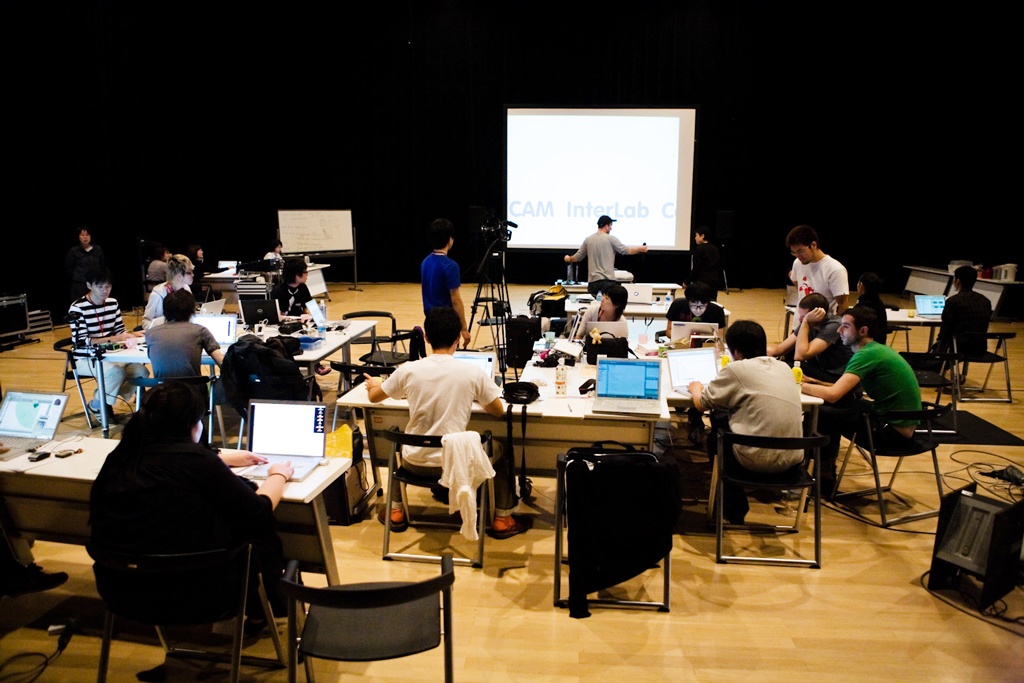YCAM InterLab Camp vol.1– “openFrameworks”
The first ever intensive course in Japan on ”openFrameworks”, a developing environment used for the creation of media art works, took place with developers Zach Lieberman and Theo Watson as instructors. The 15 participants this course for experienced persons with rather advanced programming skills included students, researchers and programmers from various backgrounds from Japan, Korea and Australia. The four-day curriculum addressing the creation of works using openFrameworks from planning to realization included lectures and workshops by the two main instructors, and a lecture by guest instructor Etsuko Uchida on the ”OpenCV” image processing library. In a presentation event on the final day, participants showcased their works and developmental achievements made during the course in front of visitors from the general public. An occasion for a small number of individuals with advanced skills to gather for concentrated work, this course instructed by the developers themselves was much more than just an opportunity to acquire new skills, as it provided at once a platform for exchange and communication with other participants and the YCAM staff.
Time: September 25-28, 2008
Lecturers: Zachary Lieberman (Media Artist, openFrameworks Developer),
Theodore Watson (Media Artist, openFrameworks Developer)
Guest lecturer: Etsuko Ueda
about openFrameworks
An immediately installable framework for interactive design and media art based on the programming language C++, openFrameworks combines various functions for 2-dimensional and 3-dimensional drawing and animation, sound/movie recording and playback, network application and interaction via mouse and keyboard, to be utilized in the production of multimedia contents. Although easy to master even without particular knowledge in programming, it has gained a reputation as a powerful image and sound processing tool. Since around 2007, openFrameworks has been used by media artists around the globe, and even though it is strictly speaking a developing environment, it was chosen for a Honorary Mention in the Interactive Art category at Ars Electronica in 2008.
http://www.openframeworks.cc/about
Course Program

Day 1:
After a basic introduction to this course, the instructors and participants introduced their respective fields of activity and study, along with examples of their work. This was followed by a C++ tutorial and lecture explaining the characteristics, structure and use of openFrameworks.

Day 2:
The participants were split up into four groups – ”live performance”, “audio-visual”, “computer vision” and “physical computing linked with other libraries/platforms” – according to their interests and areas of study, and formulated their respective final challenges in this course. Constructive exchange among the variedly skilled participants informed the technical acquisition of openFrameworks, and the group members’ creative work on their assignment.

Day 3:
Held on this day was a lecture introducing ”OpenCV”, an image processing library based on C++ just like openFrameworks, and the add-on expansion method in openFrameworks.


Day 4:
Software devised by the participants in the course’s final assignment was presented and reviewed. Regardless of the limited timeframe of four days, a variety of projects were introduced that highlighted the user-friendliness and creativity of openFrameworks. The participants are continuing to report and inform about their activities and creations via mailing lists and other means even after the end of the course.
Lecturers
Zachary Lieberman
Zachary Lieberman’s work uses technology in a playful and enigmatic way to explore the nature of communication and the delicate boundary between the visible and the invisible. He creates performances, installations, and on-line works that investigate gestural input, augmentation of the body, and kinetic response. Working with collaborator Golan Levin, he created a series of installations – “Remark” and “Hidden Worlds” – which presented different interpretations of what the voice might look like if we could see our own speech. These were followed with “Messa Di Voce,” a concert performance in which the speech, shouts and songs of two abstract vocalists were radically augmented in real-time by interactive visualization software. He is currently working on a concert-performance, “Drawn,” in which live painted forms appear to come to life, rising off the page and reacting to the world around them. Lieberman is also developing a suite of software for disabled students that transforms their movement into an audio-visual response as a means for performance and self-expression.
http://www.thesystemis.com/
Theodore Watson
Theodore Watson is an artist, designer and experimenter whose work is born out of the curiosity and excitement of designing experiences that come alive and invite people to play. Theodore’s work ranges from creating new tools for artistic expression, experimental musical systems, to immersive, interactive environments with full-body interaction. His recent work includes the Graffiti Research Lab’s Laser Tag, laser graffiti system and Funky Forest, an immersive interactive
ecosystem for young children. Theodore works together with Zachary Lieberman on openFrameworks,
which is an open source library for writing creative code in C++. Theodore Watson’s work has been shown at MoMA, Tate Modern, Ars Electronica, The Sundance Film Festival, Res Fest, REMF, Cinekid, Montevideo, OFFF, SHIFT, ICHIM, The Creators Series, Deitch Projects, Eyebeam, Pixel Gallery, Museum N8 Amsterdam.
http://www.theowatson.com/
Organized by: Yamaguchi City Foundation for Cultural Promotion
In association with: Yamaguchi City, Yamaguchi City Board of Education
Agency for Cultural Affairs, Government of Japan (FY 2008)
Produced by: YCAM IntrLab, Yamaguchi Center for Arts and Media [YCAM]



